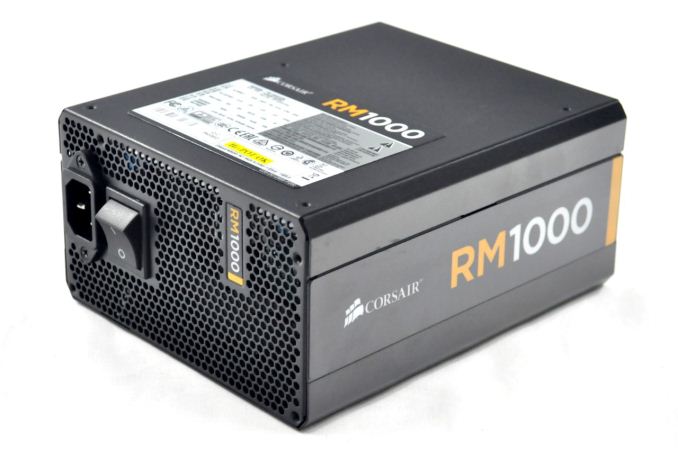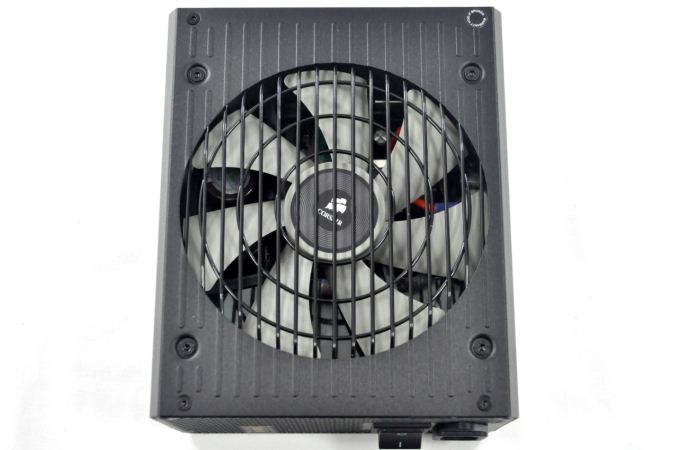Corsair RM1000 Power Supply Review
by E. Fylladitakis on April 24, 2014 6:00 AM EST- Posted in
- Cases/Cooling/PSUs
- Corsair
- PSUs
- RM Series
Conclusion
Most of Corsair's products are focused on specific target groups and the RM PSU series is targeted towards advanced users who appreciate silence above all else. The RM1000 that we reviewed today is the most powerful unit of the series, capable of feeding very high performance gaming systems. It's actually rather strange that the series would expand up to a 1000W unit; it is not impossible to build a system that would require such a massive level of power while remaining quiet, but it would be bulky and very costly. Nevertheless, if you are trying to build a very powerful and low-noise system, the RM1000 is there to lend a hand. Moreover, even though the RM1000 is focused on low-noise operation, it does not mean that Corsair neglected its performance or appearance.
Visually, the subtle modifications, such as the chamfered edges and the rimmed bottom, make the fully modular RM1000 aesthetically pleasing without standing out too much. The all-black, sleeveless cables are another attraction of the unit, as I feel they are visually superior to sleeved color-coded cables; however, because of their ribbon-like design with the wires bonded together, the cables of the RM1000 are a bit stiffer to turn and route than typical cables.
The electrical performance of the RM1000 is very good and we expected nothing less from a CWT platform, which usually are very well designed and made. The RM1000 is highly efficient and remains so even when the ambient temperature increases significantly, which is infrequent even for very advanced designs. It also provides good quality power, with low voltage ripple even under heavy stress.
Where the RM1000 could use some improvement is on thermal performance, as it seems unwise to heavily tune a 1000W unit with such small heatsinks towards low-noise operation. Despite that, the RM1000 kept performing very well during our testing, even with the ambient temperature much higher than its 40 °C rating, but the temperature of the unit increased to uncomfortable levels and the cooling system could not do anything to react because the fan's speed was already maxed out.
When it comes to quality, the Corsair RM1000 scores very well, yet there is room for improvement. The unit is very well made, with an excellent soldering and assembly job. Most primary components come from very reputable manufacturers, such as Nippon Chemi-Con and TAICON. However, some components come from manufacturers with a mediocre reputation, such as the CapXon capacitors on the secondary side of the transformer. Corsair must know what they are doing though, as they are covering the RM1000 with a five-year warranty.
The MSRP of the RM1000 is $199.90 but we found it online for $169.99 after rebate. It's not the cheapest 1000W unit with an 80 Plus Gold certification, but considering the quality and performance of the PSU, the price is justifiable. If you are the kind of user that wants a really powerful PSU tuned for low-noise operation, the RM1000 should find its way into the top few spots of your shortlist.












55 Comments
View All Comments
dirtyferret - Thursday, April 24, 2014 - link
too bad every professional reviewer disagrees with that opinionfrewster - Thursday, April 24, 2014 - link
Thanks for the good laugh. There seems to be an influx of people who believe that any PSU not made by Seasonic is trash, but that's BS.meacupla - Saturday, April 26, 2014 - link
The fan itself is a cheap sleeve bearing type.I don't understand why these companies opt for fans that can't be orientated horizontally without increased wear and noise. And the thing is, the price difference between a sleeve and double ball bearing fan is only about $1
benbenkr - Monday, May 12, 2014 - link
There's one issue these pro reviewers never seem to mention, coil whine. It doesn't inherently make a PSU bad, but boy it is annoying.I just replaced a RM650 due to the insane coil whine it has, even at low level loads.
The CWT made RM Corsair PSUs are quite solid, credit where it is due. But the coil whine is ridiculous. For that, I needed to change to a Seasonic KM3-based platform in the spirit of a Cooler Master (I know, a brand notorious for horrible PSUs) V700.
frewster - Thursday, April 24, 2014 - link
I don't think you know what you're talking about. Those ones made by Chicony? They're on par with Delta quality PSUs. And CWT? Hardly "horrible."YoloPascual - Saturday, April 26, 2014 - link
Yeah the server psu's that are made by Chicony are on par with Delta. The RM750 and RM850 are not. CWT made HX series are very good. CWT made RM series are mediocre at its finest. I does not need to be Seasonic/Super Flower made, but it should competent.just4U - Thursday, April 24, 2014 - link
I wish they'd use seasonic more.Voldenuit - Thursday, April 24, 2014 - link
I have a CWT ODM Corsair CXM-500 in my rig. My beef with it is that while it is pretty quiet at idle, running a GPU load (gaming, video benchmarks) on my GTX 760 will bring the fans up until it becomes the noisiest component in my system.Running a pure CPU load (undervolted i5 4670K) such as Prime95 does not elicit this behaviour, and I've controlled for other variables such as case, CPU and GPU fan speeds, so the threshold for "noisiness" from the PSU seems to be around 200-250W, which would correspond to a 40-50% load on the PSU.
It's not unbearable, and not worth returning or exchanging the unit, but it was a bit disappointing for me since I was trying to build as quiet a system as I could on my budget.
Voldenuit - Thursday, April 24, 2014 - link
PS It's worth noting that I don't have any sound measuring equipment, so I don't have any SPL measurements, and that my personal threshold for noise and my apartment noise floor might be very different from others'.I've seen posts both praising and condemning the same CX-500M (sorry, had the model number mixed up in OP), so YMMV.
lorribot - Thursday, April 24, 2014 - link
Does truly have a "chamfered edges and the rimmed bottom" as you state in the conclusion or should that be a ribbed bottom?